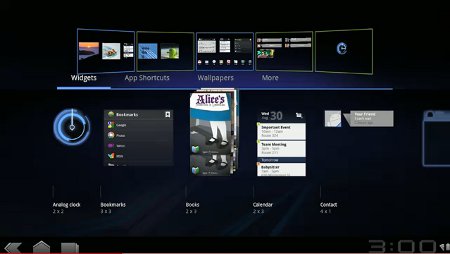Google previews slick, tablet-oriented Android 3.0
Jan 6, 2011 — by Eric Brown — from the LinuxDevices Archive — 1 viewsGoogle released a video overview of Android 3.0 (“Honeycomb”), confirming that it is designed for tablets while hinting at exclusivity for tablets. Honeycomb enhancements include a revamped, “virtual and holographic user interface,” improved multitasking, drag and drop widgets, video chat with Google Talk, Google eBooks integration, and tablet-oriented overhauls for the browser, Gmail, and YouTube.
With Asus, LG, and Motorola announcing their Honeycomb tablets yesterday, Google released a preview video of Android 3.0 in anticipation of a formal release date many expect will to coincide with Mobile World Congress in February.
The brief Google preview video for Honeycomb confirms several widely, but not universally held assumptions: First — as we had already learned from Asus' announcement of its Honeycomb-based Eee Pad tablets yesterday — it's Android 3.0, not Android 2.4. Second, it supports an optimized display on larger screens and higher resolutions.
Multiple windows and drag and drop widgets in Android 3.0
(Click to enlarge)
Android 2.3 and earlier releases topped out at about five or six inches. But, as we now know from the Motorola Xoom tablet announcement, Honeycomb supports at least 10.1-inch screens, with 1280 x 800 resolution.
In addition, Honeycomb would appear to represent a virtual, if not formal, fork of Android — its first, if you don't count the advancements of Android 2.0/2.1, which pretty much left older G1-style processors behind.
In the words of Android creator Andy Rubin in his blog introduction to the Honeycomb video demo, Honeycomb is "designed from the ground up for devices with larger screen sizes, particularly tablets."


Android 3.0 main screen (left) and virtual keyboard (right)
(Click on either to enlarge)
Google does not mention hardware requirements for the release, but judging from the slick capabilities shown in the video, it would seem that some baseline must exist. The rumor that Honeycomb requires a dual-core processor appears to be proven untrue by the Snapdragon-based Asus Eee Pad MeMo tablet. The MeMo also demonstrates that the release supports tablets as small as seven inches, in addition to 10.1-inch tablets like the Motorola Xoom.
For the record, an Engadget story quotes Google's Dan Morrill as tweeting in response to a question on requirements, "There's no hard minimum processor requirement for Honeycomb. Trust me, if there were, I'd know."


Android 3.0 revamped YouTube interface (left) and Google Talk video chat (right)
(Click on either to enlarge)
We've developed a brand new, truly virtual and holographic user interface. Many of Android's existing features will really shine on Honeycomb: refined multitasking, elegant notifications, access to over 100,000 apps on Android Market, home screen customization with a new 3D experience and redesigned widgets that are richer and more interactive. We've also made some powerful upgrades to the web browser, including tabbed browsing, form auto-fill, syncing with your Google Chrome bookmarks, and incognito mode for private browsing.
Meanwhile, both the blog post and the video suggest the following enhancements:
- improved multitasking with multiple windows UI
- carousel-style horizontal scrolling in many apps
- drag and drop widgets
- Google Maps 5 with 3D interactions and offline reliability
- access to over three million Google eBooks, with page-turning ebook interface
- Google Talk, now with video and voice chat with any other Google Talk device
- redesigned YouTube
- tablet-enhanced Gmail
If Honeycomb does represent a formal fork of Android, presumably, some of these enhancements will show up in whatever smartphone-oriented Android version follows Android 2.3 ("Gingerbread"). Announced only a month ago, Android 2.3 seems somehow forgotten at CES in between a raft of Android 2.2 phones and Android 3.0 tablets.
We'll swing back to the Honeycomb details in the future, but in the meantime, here's the video.
Google's Android 3.0 demo on YouTube
Source: Google
(Click to play)
The Google blog posting on Android 3.0 may be found here.
This article was originally published on LinuxDevices.com and has been donated to the open source community by QuinStreet Inc. Please visit LinuxToday.com for up-to-date news and articles about Linux and open source.
